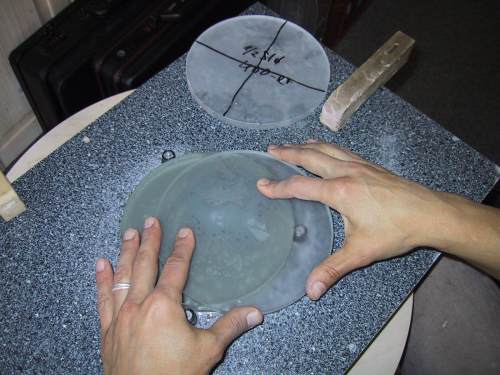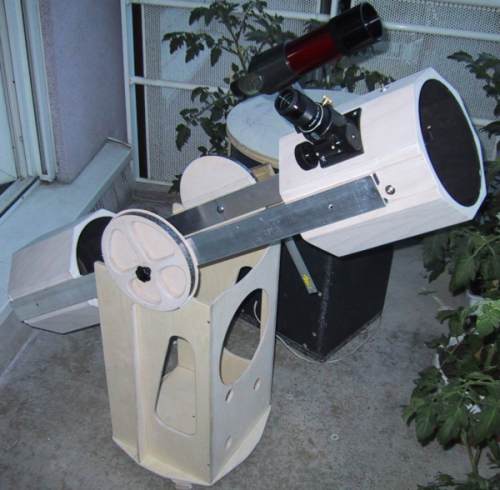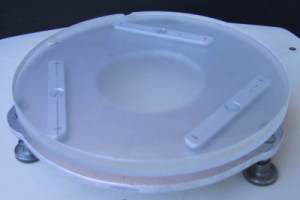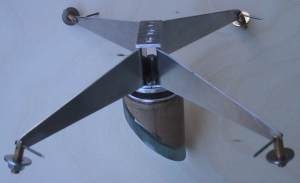| Home | Material | My Telescopes | Mirror Making | Deep Sky | ext. Links |
| 32" Mirror | 24" Kyklopas | 17,5" Aristarchos | 14" Mirror | 10" Archimedes | 10" Travel Dobson | 24 cm Quints | 17 cm Twins | 6" Traveldobson |
| Deutsch (de)![]()
| Home | Material | My Telescopes | Mirror Making | Deep Sky | ext. Links |
| 32" Mirror | 24" Kyklopas | 17,5" Aristarchos | 14" Mirror | 10" Archimedes | 10" Travel Dobson | 24 cm Quints | 17 cm Twins | 6" Traveldobson |
The 17 cm f/6.3 Twins
Initially I wanted to Buy two low cost starter scopes for my relatives (mainly for the children) but the scopes that I got for 70,- Euros from the "LIDL" discount market I returned as they were totally astigmatic. (see the story in "ATM goes LIDL" in the German Astrotreff forum). On top of this, I found this parallactic mount to flumpsy to handle. How shall the children manage that?
 |
So, I got out the two 6.6" glass blanks, that were lying around and oh, I had again carbo 80 between my fingers. The glass is just 10,6 mm (0.42") thick, a bit too thin, but it worked better than I thought. |
All this is a lot of work and much more expensive than a "Lidl", but with 6.6 inch aperture you can see lots of nice objects an finally - it can't be bad to have a serious scope on my favourite Island Thassos. I chose a focal ratio of f/6.3 to enable observing in a sitting position and to get on the other hand nice views even with eyepieces of more simple design.

|
Mostly I stuck to the 2 parallel- bar design from Albert Highe (thank you Albert for the Idea), but glued together the tube pieces for the mirror box and upper cage to octagons from 3 mm plywood. The bars are from 50x15x2 mm (2x0.6x0.08") rectangle aluminum tube, that nest in wooden ledge guides, to give a firm seat with just one bolt each. The fit is very stable and keeps collimation quite well. With this design the altitude bearings can be mounted directly at the bars, which is an advantage particularly with smaller scopes, that have a relatively high balance point. The parts like diagonal, 8x50 finder and eyepieces I got from the Taiwanese Dobsonians via ICS. |
 |
For this thin a mirror I made a 6 point flotation cell. After being coated, it was silicone glued at the ends of the 3 bars (see picture). Collimation is done by tilting the whole aluminum base with springs and hand knobs (see picture) against the mirror box bottom (see picture from the back side). |
 |
The spider consists of a 30x15x2 mm rectangle aluminum tube, where the angled fins (1 mm aluminum) are put through. (separate parts see picture). Due to the excentric design it is of enormous stiffness, it would have done for a 18" as well. Collimation is done via 4 bolts that press against an al-plate pulled by a central bolt. This setup is also much stiffer, than the central bolt design, that I see in most commercial spiders. |
Setup
In this case it proved superior to deviate from the rule of "no tools setup" and use a hex key.
Transport
Performance
At 30. May 2004 war first light with the uncoated mirrors:
- Set up and tear down is done very fast an easy. Collimation was kept during several set ups.
- The bar tube is very stiff, but the rocker shakes due to the height a bit more than I am used from my low profile Dobs.
- The handling is easy and comfortable, light years ahead of this department store mounts. Even the children will be able to observe while seating. The relatively large finder gave me some hart time to balance it out, but it makes it easier finding objects even in moderately light polluted areas. The 1.5° true filed of the 32 mm Plossl should be sufficient to center the objects in the main instrument.
- The scopes delivered nice pictures of the Moon, Jupiter and Venus. The star test revealed on both mirrors some hint of overcorrection, but still way inside the green limits. The ICS Plossls had no problem with the f/6.3, astonishing how cheap well done eyepieces can be, if you are used to Nagler at f/4.1 .
I am confident, that even novices will get familiar with this scopes in short time and can have much fun with them.
During the Venustranit 8th of June one twin was in real action:
Improvements
To top of this page
Home | Imprint | Privacy Policy | about |